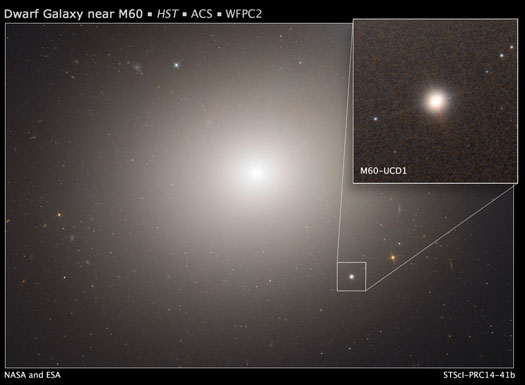| Sep 17, 2014 |
Hubble helps find smallest known galaxy with a supermassive black hole
|
|
(Nanowerk News) Astronomers have found an unlikely object in an improbable place: a monster black hole lurking inside one of the tiniest galaxies known.
|
|
Though the black hole is five times the mass of the black hole at the center of our Milky Way, it is inside a galaxy that crams 140 million stars within a diameter of about 300 light-years, only 1/500th of our galaxy's diameter.
|
|
The dwarf galaxy containing the black hole, called M60-UCD1, is the densest galaxy ever seen. If you lived inside of it, the night sky would dazzle with at least 1 million stars visible to the naked eye (as opposed to 4,000 stars in our nighttime sky, as seen from Earth's surface).
|
 |
| Looking almost like a bright star near the massive elliptical galaxy M60 (also called NGC 4649), the dwarf galaxy M60-UCD1 crams 140 million stars within a diameter of about 300 light-years. The dwarf galaxy may actually be the stripped remnant of a larger galaxy that was torn apart during a close encounter with the more massive galaxy. Circumstantial evidence comes from the recent discovery of a monster black hole (too small to be seen in this Hubble Space Telescope picture) at the center of the dwarf. The black hole is 15 percent the mass of the entire galaxy — way too big for it to have formed inside a dwarf galaxy. But the black hole would be the right proportional mass if the galaxy had once been more massive. The galaxy lies 50 million light-years away inside the immense Virgo Cluster of 2,500 galaxies. M60-UCD1 orbits the giant elliptical galaxy in this image. M60 is 120 million light-years across and contains an estimated 400 billion stars.
|
|
The finding implies that there are many other very compact galaxies in the universe that contain supermassive black holes. The observation also suggests that dwarf galaxies may actually be the stripped remnants of larger galaxies that were torn apart during collisions with yet other galaxies — rather than small islands of stars born in isolation.
|
|
"We don't know of any other way you could make a black hole so big in an object this small," said University of Utah astronomer Anil Seth, lead author of an international study of the dwarf galaxy published in Thursday's issue of the journal Nature.
|
|
His team of astronomers used the Hubble Space Telescope and the Gemini North 8-meter optical and infrared telescope on Hawaii's Mauna Kea to observe M60-UCD1 and measure the black hole's mass. The sharp Hubble images provide information about the galaxy's diameter and stellar density. Spectroscopy with Gemini measures the stellar motions as affected by the black hole's pull. These data are used to calculate the mass of the unseen black hole.
|
|
Black holes are gravitationally collapsed, ultracompact objects that have a gravitational pull so strong that even light cannot escape. Supermassive black holes — those with the mass of at least 1 million stars like our Sun — are thought to be at the centers of many galaxies.
|
|
The black hole at the center of our Milky Way galaxy has the mass of 4 million suns, but as heavy as that is, it is less than 0.01 percent of the Milky Way's total mass. By comparison, the supermassive black hole at the center of M60-UCD1 is a stunning 15 percent of the small galaxy's total mass. "That is pretty amazing, given that the Milky Way is 500 times larger and more than 1,000 times heavier than the dwarf galaxy M60-UCD1," Seth said.
|
|
One explanation is that M60-UCD1 was once a large galaxy containing 10 billion stars, but then it passed very close to the center of an even larger galaxy, M60, and in that process all the stars and dark matter in the outer part of the galaxy got torn away and became part of M60.
|
|
The team believes that M60-UCD1 may eventually be pulled back to merge with the center of M60, which has its own monster black hole, weighing a whopping 4.5 billion solar masses (more than 1,000 times bigger than the black hole in our galaxy). When that happens, the black hole in M60-UCD1 will merge with the far more massive black hole in M60. The galaxies are 50 million light-years away.
|

